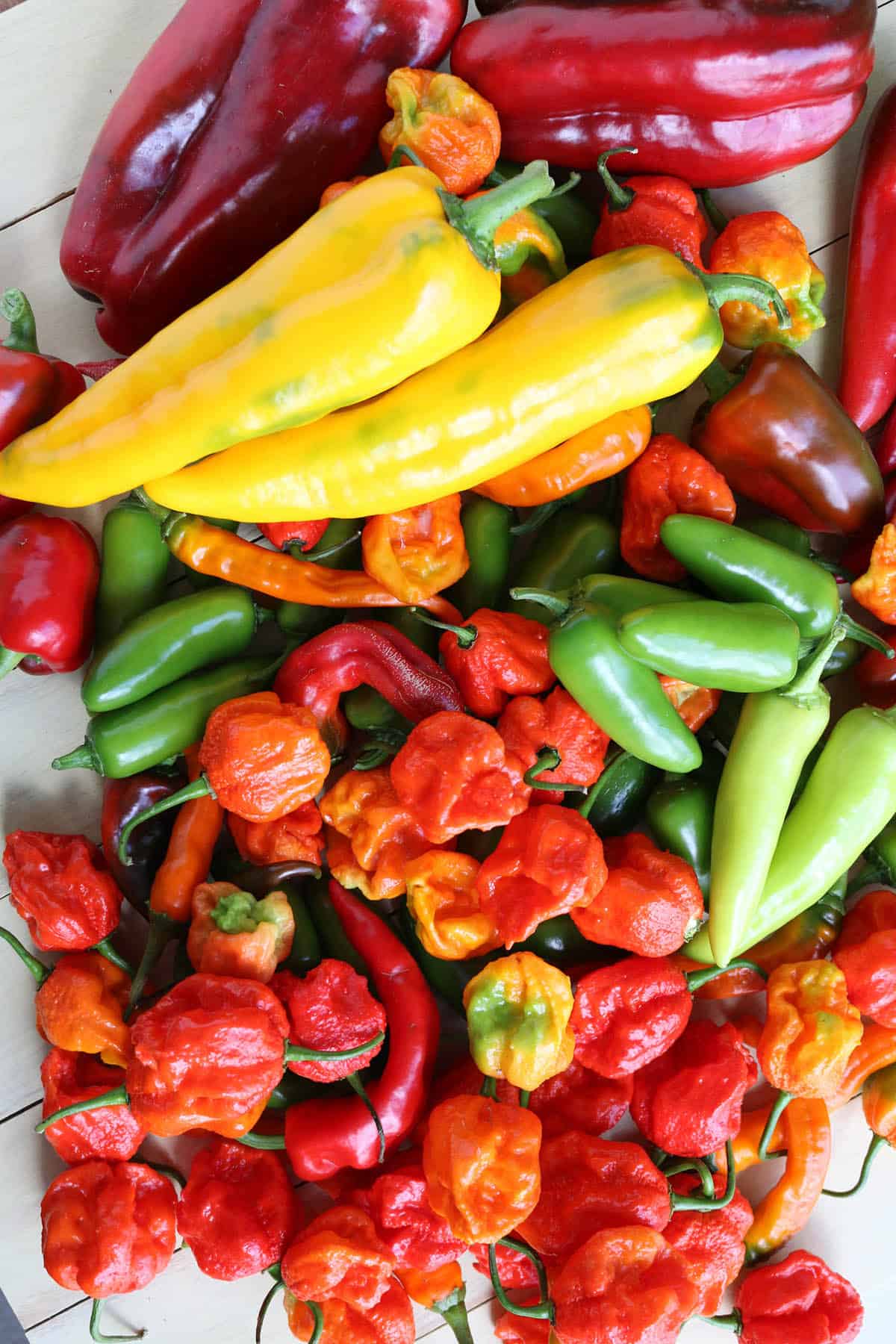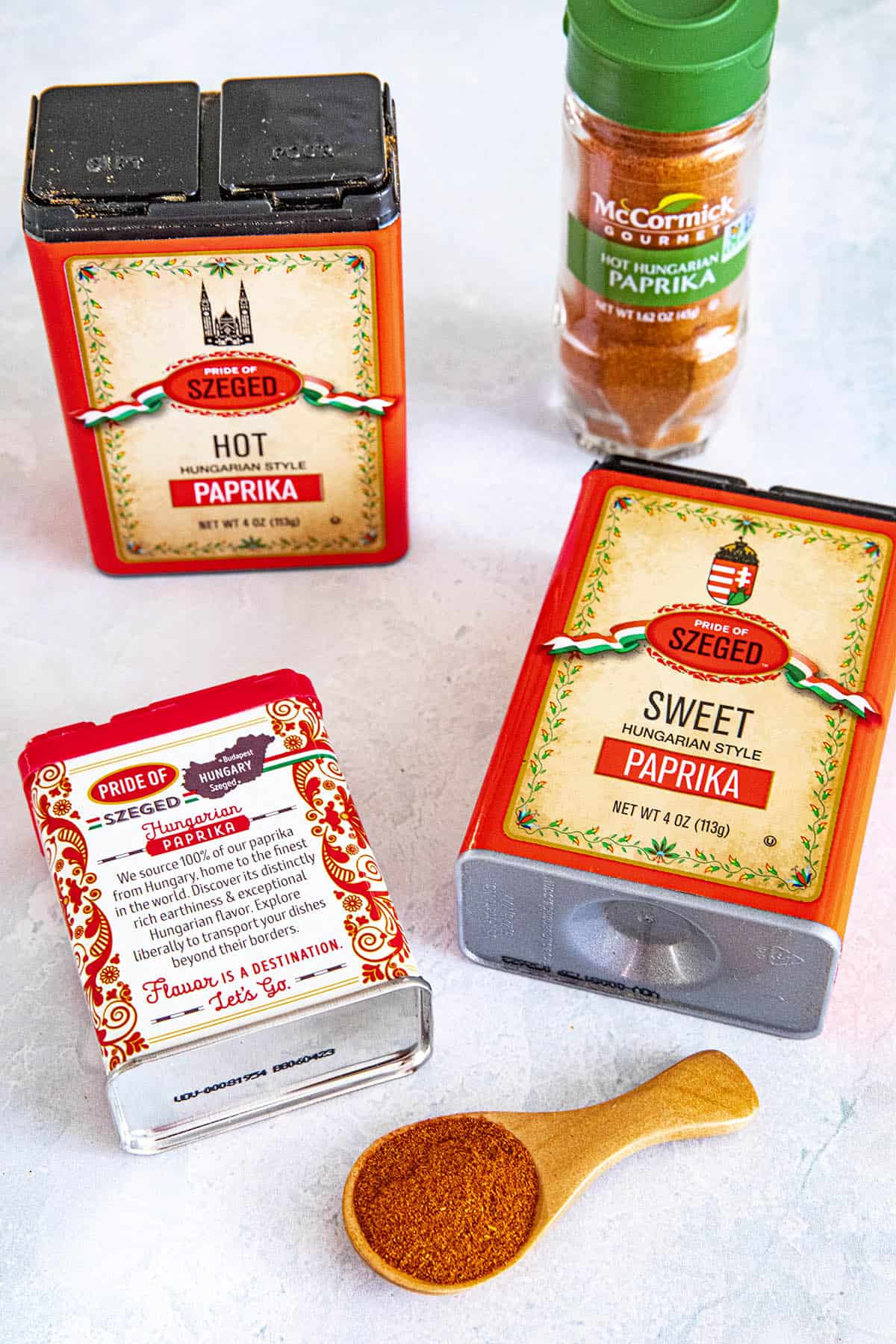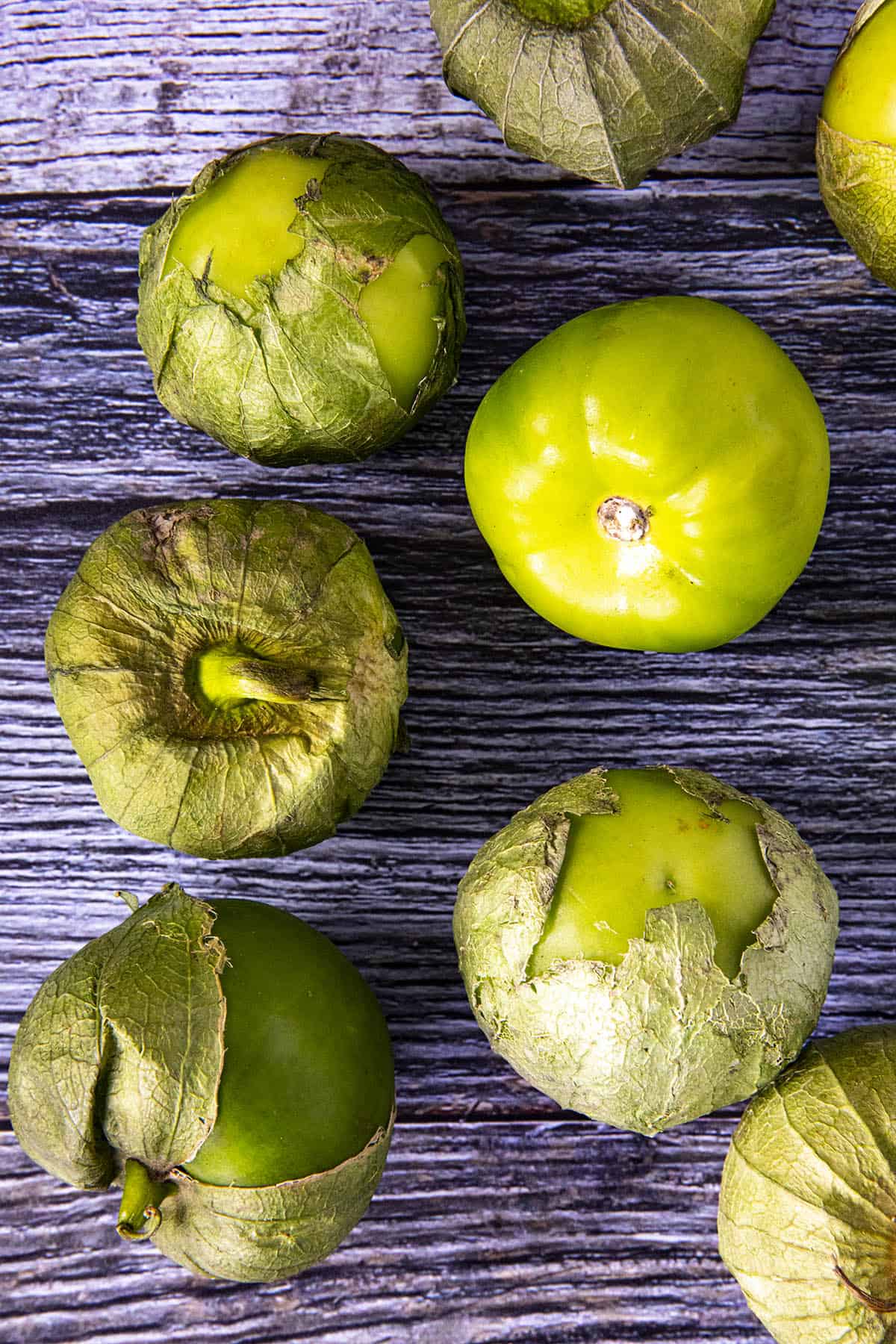Learn how to make gumbo, with recipes and notes for making different types of gumbo, from Cajun style to Creole style, with many tips and techniques.
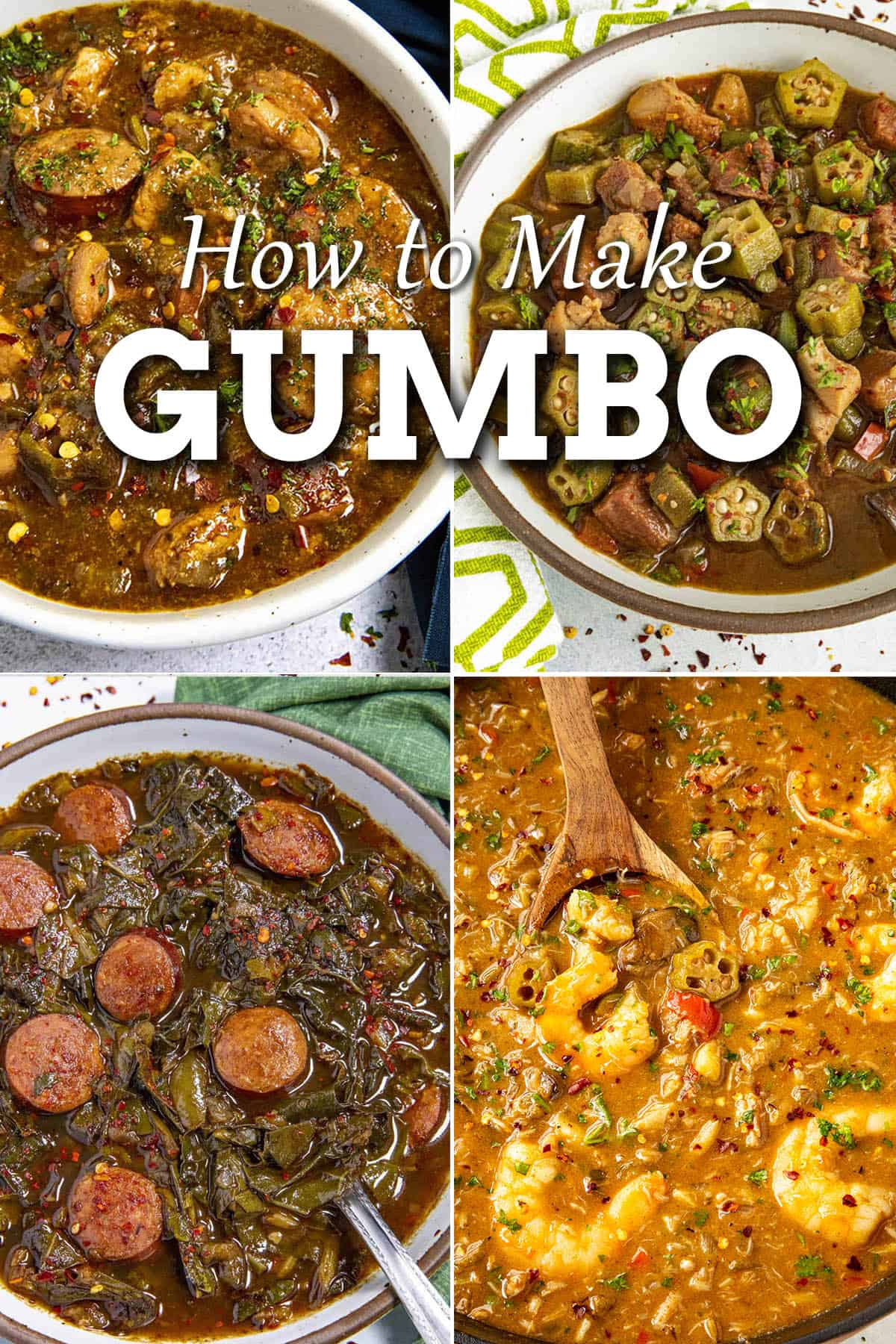
There is a reason gumbo, the quintessential soup-stew, is the Official State Cuisine of Louisiana. Rich in both history and flavor, it represents the cultural mix of the area.
Before its purchase in 1803 by the United States, Louisiana was populated by a myriad of diverse cultures, including French, Spanish, African, Irish, American Indian, Italian, Southern and more.
Together, each of those cultures influenced the cuisine, resulting in some of the most iconic dishes in not only the south, but in America.
Case in point: GUMBO. Gumbo reflects the wisdom of each culture’s approach to cooking, garnering it the distinctive honor as the Official State Cuisine of Louisiana.
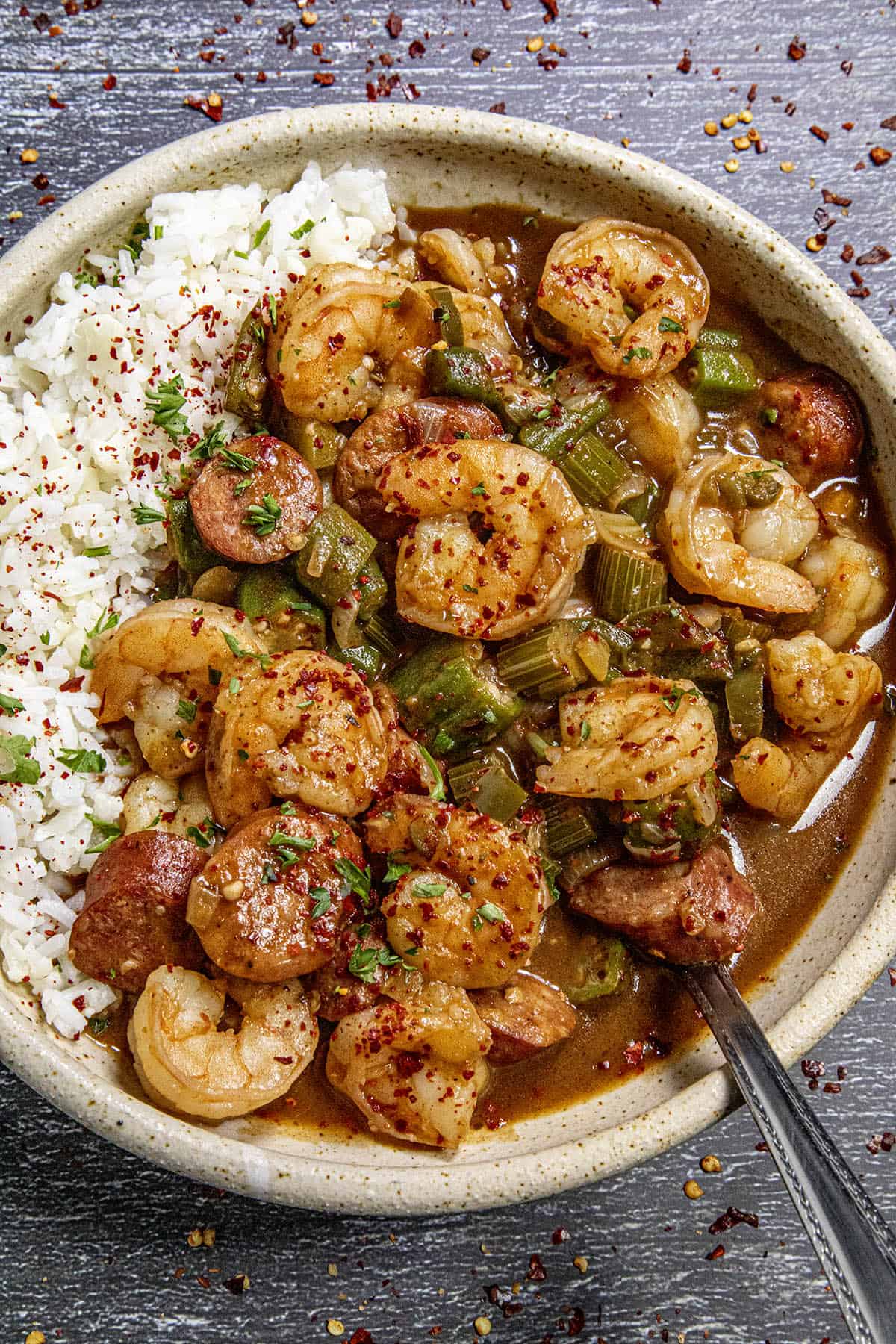
About Gumbo
At its heart, gumbo is a cross between a soup and a stew, depending on which region you’re starting from, consisting of a thickener, such as a French roux, along with the Holy Trinity of celery, bell peppers and onions, treated with a stock and filled with a variety of meats and seafood.
Andouille, a spicy smoked pork sausage, is the most popular choice, along with shrimp and gumbo crab, though there are numerous options, particularly considering such easy access to the Gulf of Mexico.
With so many cultures influencing a dish, you will naturally find different varieties of gumbo, each emphasizing a particular culture or region, and this is by far one of the greatest gifts gumbo has given us, a chance to explore and experience those cultures in a single bowl.
When making a traditional gumbo, the most important step to master is the making of the roux. It is not a difficult process, but it does require time and attention.
Simply a mixture of flour and fat, such as butter or oil, it needs to be constantly swirled over a gentle heat for 20 to 45 minutes or even longer until it browns to the color of choice, from the warming shade of peanut butter to the rich dark brown of chocolate.
Each will yield different results and flavors. Okra is not as popular as it once was, though filé powder (ground sassafras leaves) is still a widely used ingredient to finish.
Let’s talk more about gumbo, shall we? Here are some common questions.
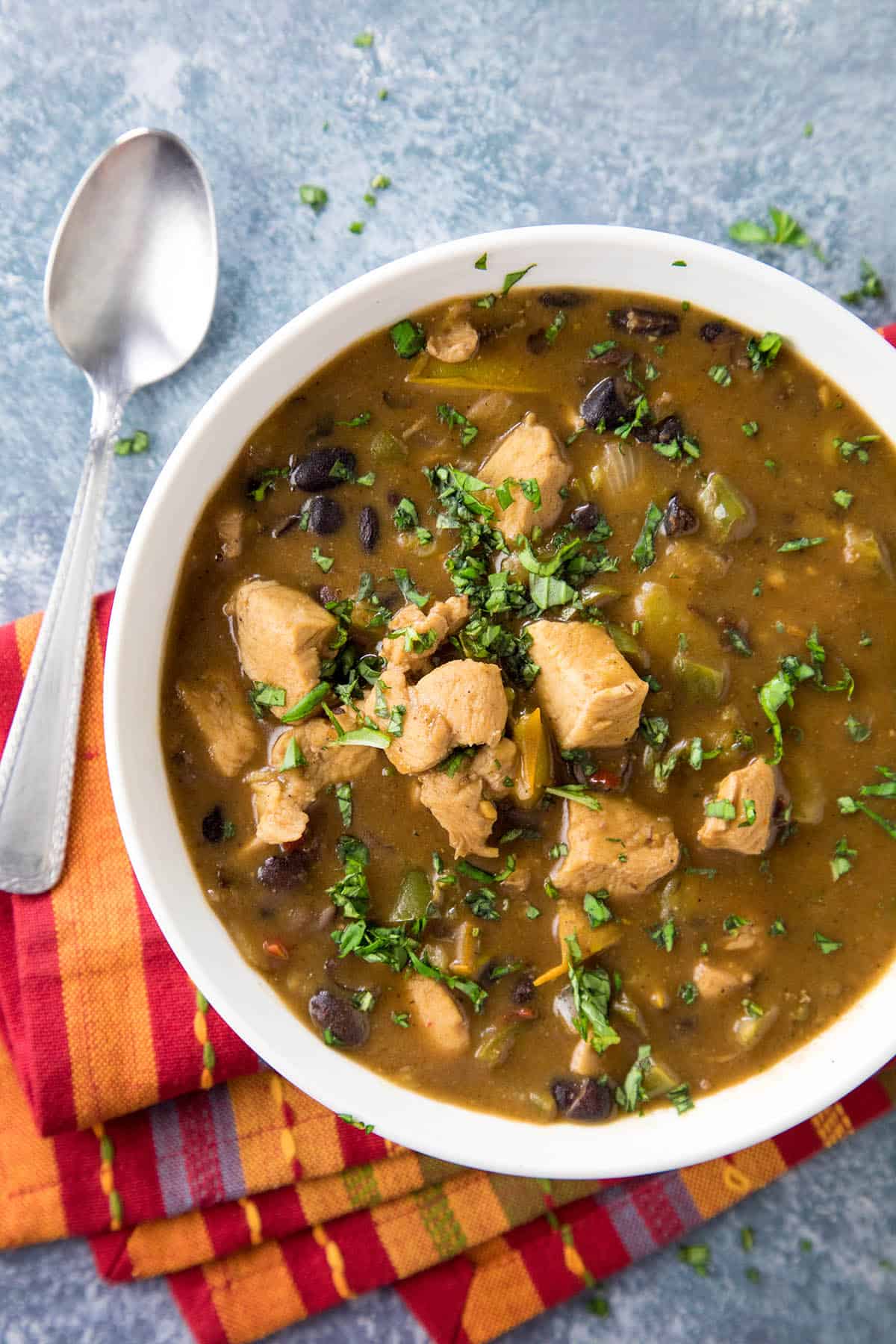
What Is Gumbo? What Makes Gumbo a Gumbo?
Gumbo is a conglomeration of different cultures and cuisines. It is essentially a stew, and it is the official state cuisine of Louisiana. It is made from stock that is thickened with a roux and sometimes includes okra or filé powder (dried and ground sassafras leaves) as additional thickeners, and often includes proteins, such as meat or seafood.
Many different cultural techniques have contributed to the evolution of today’s gumbo. The French gave it the roux. African slaves introduced okra. American Indians added filé powder, and so on.
Flat out, Gumbo is AWESOME. HUGE on flavor.
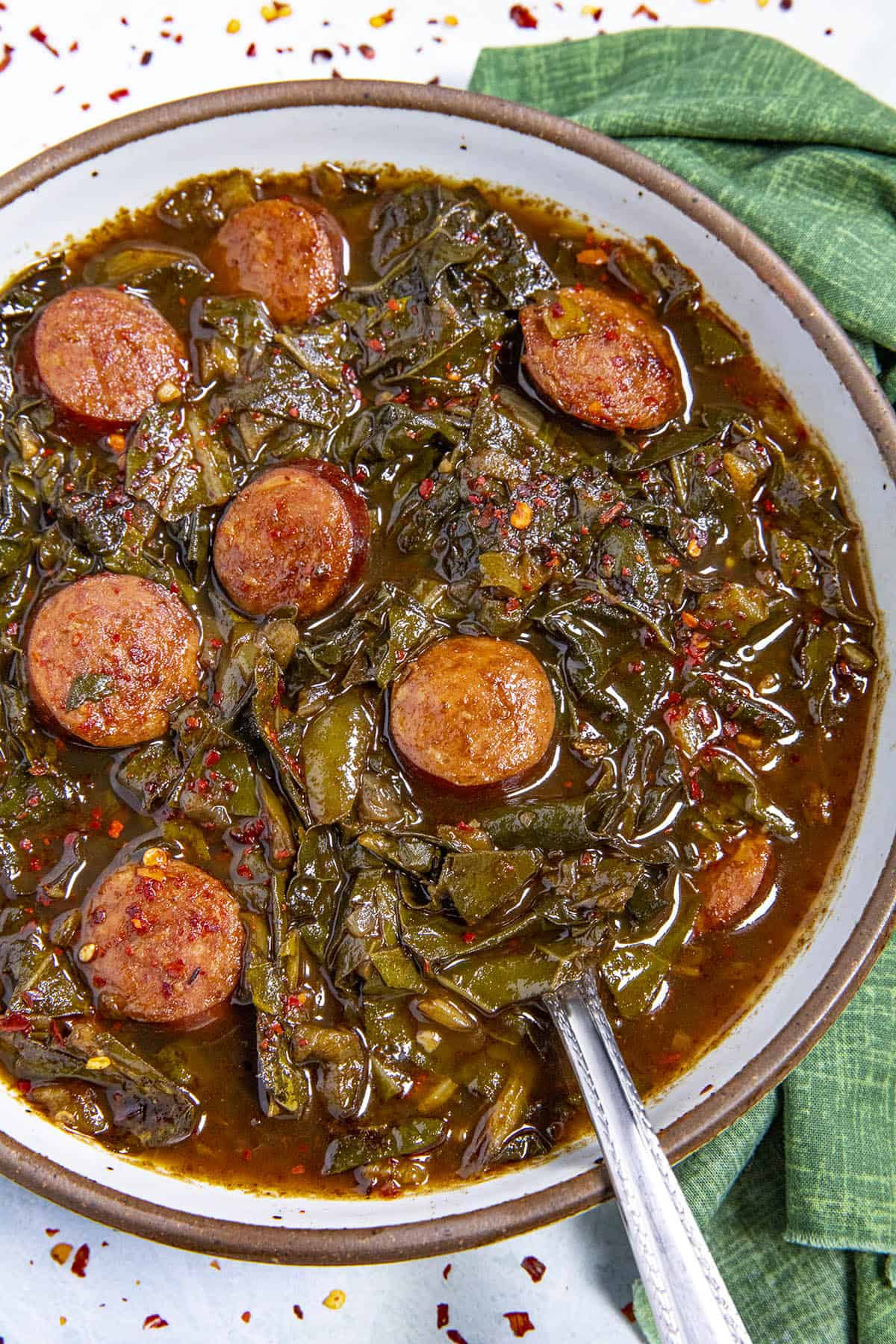
What Are the Ingredients in a Gumbo?
More traditional gumbos start with a roux – a mixture of fat and flour – then add the Cajun Holy Trinity of vegetables, which is bell peppers, onion and celery. Stock is added along with a variety of meats and seafood, such as smoked andouille sausage, chicken, gator, crab, crawfish, shrimp and more.
It is highly seasoned with a blend of Cajun seasonings – see our Homemade Cajun Seasoning Blend Recipe – or Creole seasonings, which can also vary from cook to cook.
More traditional gumbos include okra as a thickener, and can also be thickened with filé powder which is dried and ground sassafras leaves.
From there, the recipe interpretation is open to the cook, and gumbo ingredients can vary.
In Louisiana, you have influences from southern cooking, French, African, Spanish, Irish, Italian, even American Indian. That is what makes Cajun and Creole cooking so fantastic.
Let’s talk about how to make gumbo.
I’ve included links to many recipes below as well as a video detailing how you can make a typical gumbo, but here are the general steps with a bit of additional insight.
I also have included some additional discussion points below to help make sure your gumbo comes out as awesome at it can be.
Basic Steps for Making Gumbo

Breaking it down into basic steps:
- Cook your meats.
- Reserve the cooked meats.
- Make your gumbo roux.
- Check your roux and stop when you achieve your desired color.
- Stir in your vegetables and cook them down.
- Stir in the reserved cooked meats.
- Add stock.
- Simmer until it is ready.
There are further steps, such as adding your seafood and thickening with file powder, but much will depend on how you are making your gumbo.
Let’s elaborate on the cooking process.
How to Make Gumbo
First, heat up a large pot to medium heat and add your olive oil. Season your proteins, if using, such as chicken or sausage with a bit of salt and pepper and cook them down in a large pot. You only need a few minutes per side. If you’re cooking seafood, it won’t go in until near the end, as they cook up much more quickly.
Once the meat is done cooking, remove it from the pot and set aside for now.
Next add a half cup of peanut oil or butter to the pot, then slowly stir in a half cup of flour. Begin to stir immediately, constantly, for 20-30 minutes to darken your roux to the color of a light to dark chocolate. Learn more about How to Make a Roux.
See below for more information about how to make a great roux.
Next, stir in peppers, onion, celery and garlic. Give a good stir, then add the okra (if using), Cajun or Creole seasonings, stock and bay leaves. The bay leaves bring in a lot of additional flavor. Try my Homemade Cajun Seasoning blend.
Lower the heat and let the whole pot simmer for at least one hour. 1.5-2 hours is fine to develop more flavor, though you may need to add in a bit more liquid.
When it’s just about ready, add your seafood and let it simmer, 5-10 minutes or so, until it is cooked through.
When you’re ready to serve the gumbo, swirl in some fresh chopped parsley and let it cook in about 5 minutes or so. Turn off the heat. Stir in the filé powder to thicken up your gumbo even more, if you’re using it.
Finally, serve it up in a bowl as-is or over rice, whichever you prefer!
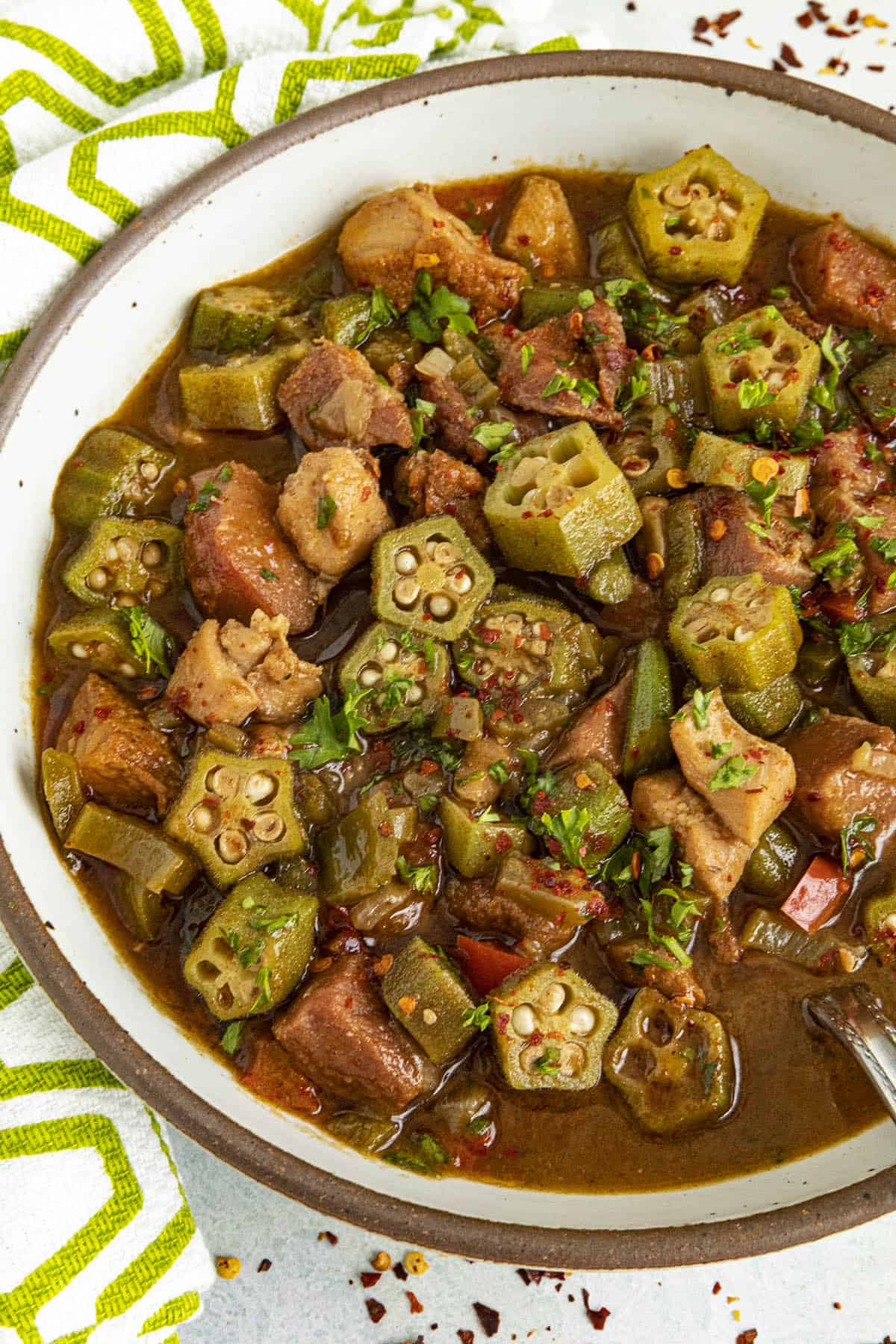
The Many Different Types of Gumbo
The gumbo recipe detailed above is a typical gumbo that I make in my own kitchen, although you will find variations from region to region.
Some regions prefer meat and sausage in their gumbo, thickened with filé powder. Along the coast they prefer seafood gumbo thickened with okra.
No protein is off limits. I’ve seen recipes for gumbo with duck meat, alligator, squirrel, deer, rabbit, turkey and more.
One tradition is to include a spoonful of potato salad in your gumbo before serving. I’ve encountered recipes with the addition of hard-boiled eggs.
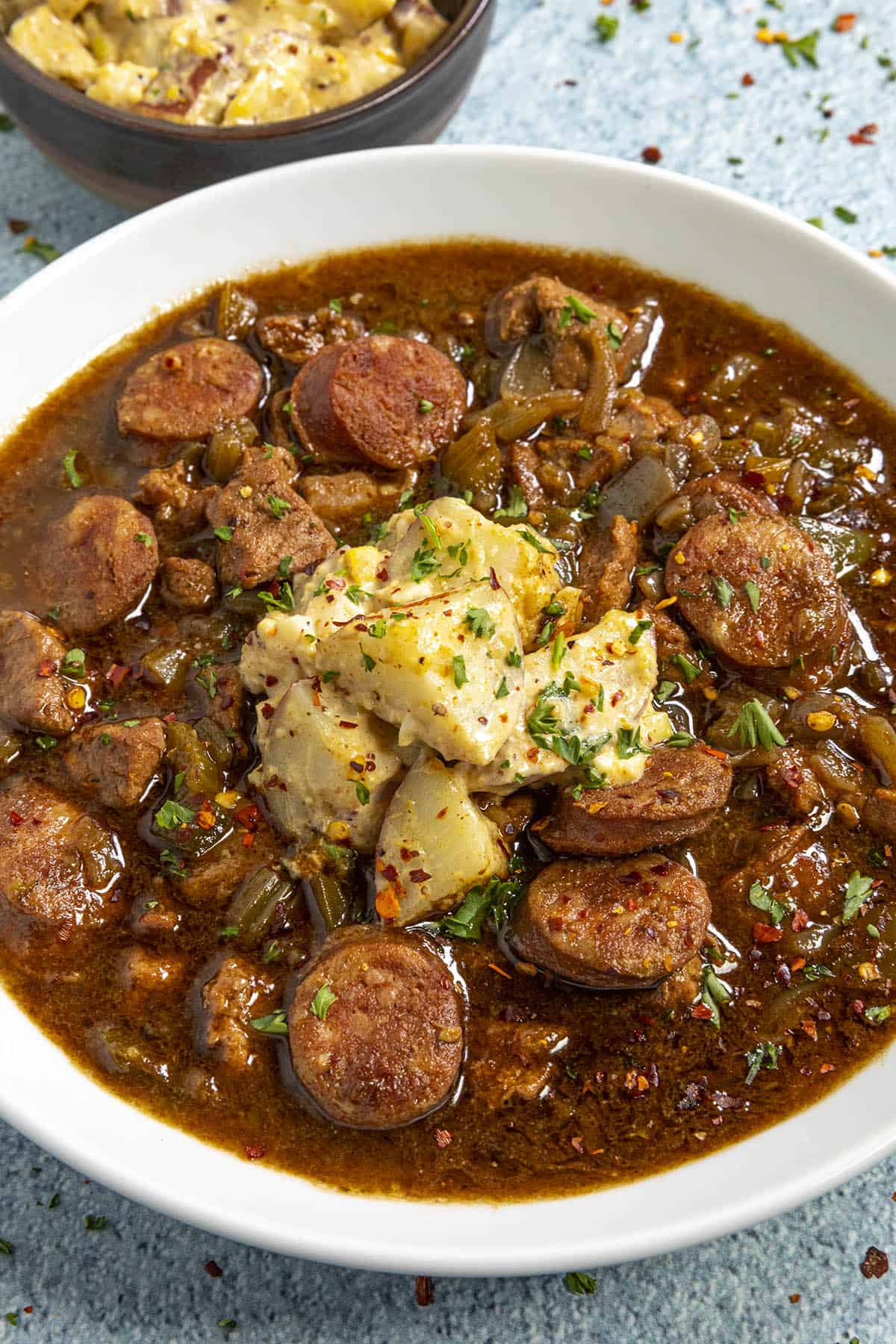
There is a very good vegetarian gumbo called gumbo z’herbes made with greens, often served during Catholic Lent.
Regardless of how you make your gumbo, it is difficult to say if there is any particular “right way” to make gumbo. If you visit Louisiana, you’ll encounter people arguing one way or another, but from chefs I met personally in Louisiana, the best way to make gumbo is “however your mama taught you.”
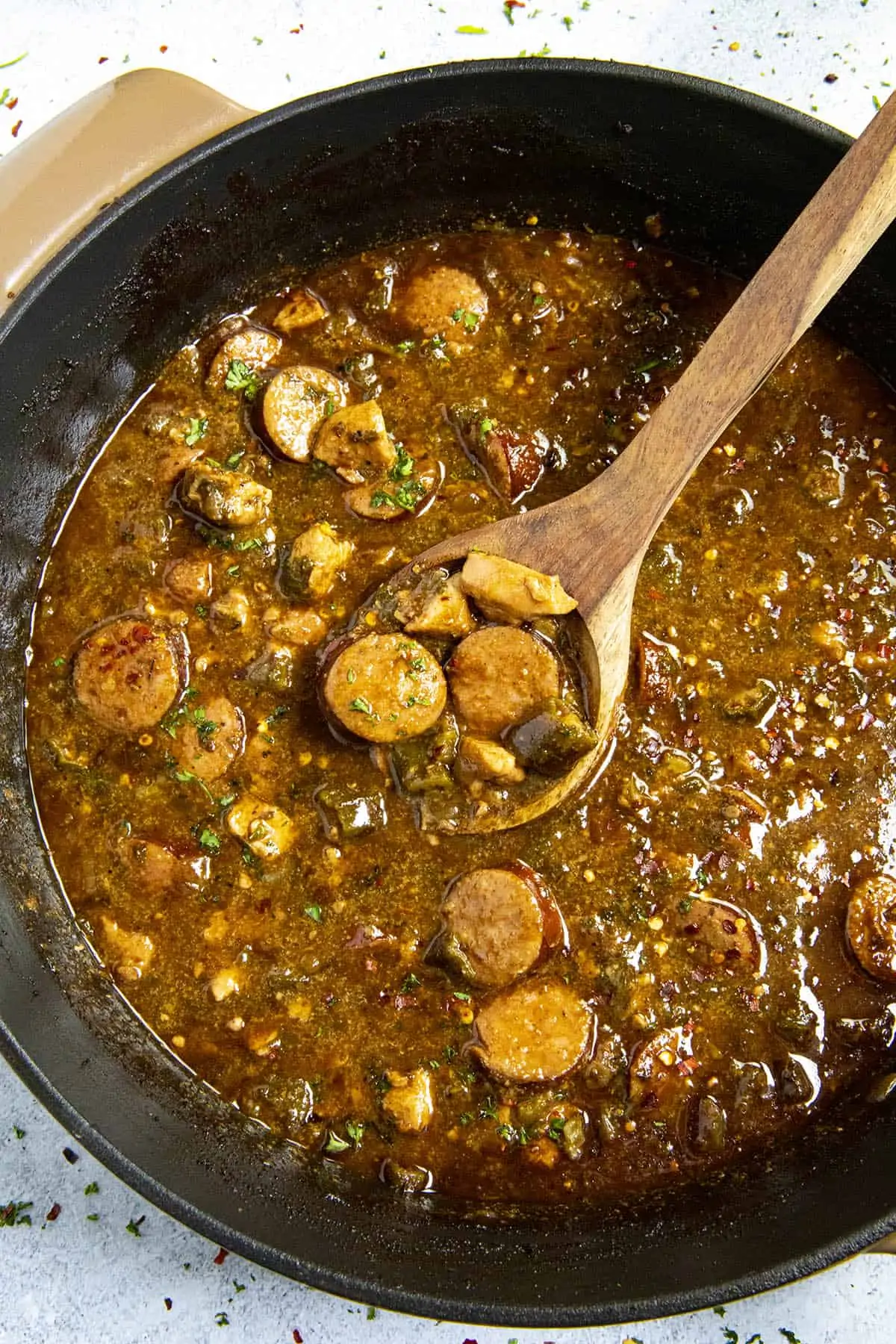
Cajun vs Creole Gumbo
There are two very basic differences between Cajun and Creole Gumbo. Modern Cajun gumbo typically starts with a roux base (of oil and flour) and does not include tomato. Creole gumbo may or may not start with a roux base (or either oil or butter and flour), and typically includes tomato. This is the simplest explanation.
However! As with any culture, there is much more to the story.
As a bit of background, the word “Cajun” is slang for “Acadian”, referring to the French settlers who populated the region. “Creole” originally referred to those born into the colonies, primarily French or Spanish.
The Acadians were incredibly resourceful people, making heavy use of the land and all it has to offer, including every part of the animal. Hence, their original cuisine was generally simpler and used fewer ingredients.
Creole cuisine is more of a blend of the many different cultures that descended upon the region, and typically uses more readily available ingredients.
Many years ago it may have been accurate to distinguish Cajun cooking from Creole cooking by the region. Creole was once considered the wealthier cuisine of the city, with more European influence, using more expensive ingredients.
Cajun cooking, on the other hand, was considered the cooking of the country people, preparing simpler food.
It isn’t quite the case any longer. Today, the lines between Cajun and Creole cooking have blurred, with the words often being used interchangeably. You’ll hear dishes described as Cajun-Creole.
It is worth noting that Cajun and Creole cooking techniques have evolved from hundreds of years of cooking and tradition with many different influences, and it is still evolving today as ingredients are introduced and other techniques learned and applied.
Still, “Creole” more frequently refers to the cuisines of the city, most notably New Orleans, where the addition of tomato is much more common as well as an abundance of other ingredients. “Cajun” generally refers to country cooking, using whatever is on hand.
As a matter of perspective, as an outsider, you will certainly notice many similarities in the cuisines, but if you live in the region, there is still a distinction between them culturally.
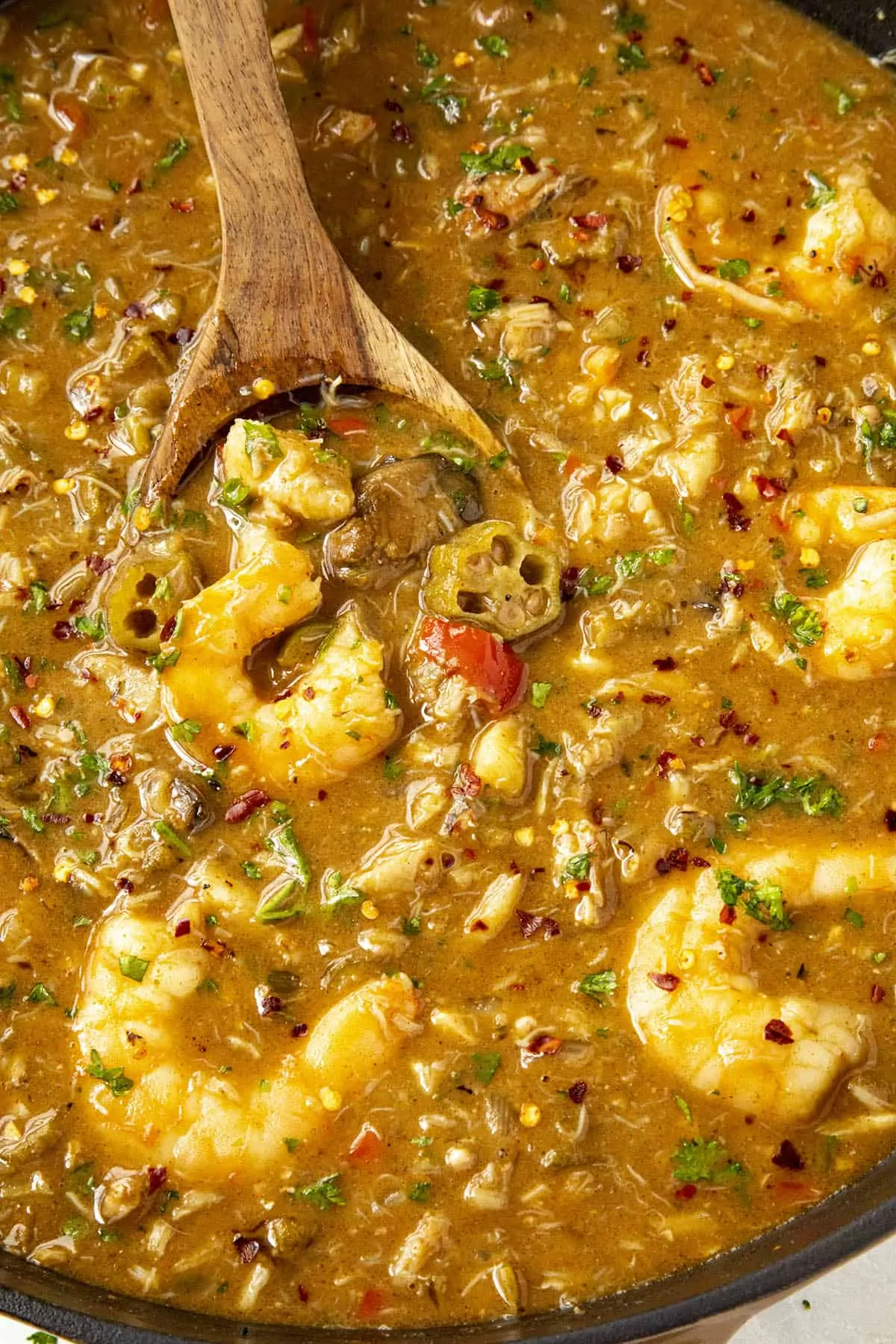
Is Okra Required for Gumbo?
Interestingly, the name “Gumbo” derives from a West African word for okra. Okra is often used as a thickener and was so very early on in the making of gumbo. However, an alternative is to use filé powder (dried and ground sassafras leaves) instead.
While visiting New Orleans, I found many gumbo recipes that do not use okra, so as an ingredient, okra is not required and is open to the preference of each cook. You’ll still run into people, though, who insist gumbo is not gumbo without okra.
I do have a great okra gumbo recipe, however, that focuses on the thickening power and flavor of okra, which I think you might enjoy.
What is the Cajun Holy Trinity?
The French have the mirepoix – carrots, celery, onion – and French cuisine has heavily influenced Cajun cooking. When the French landed in Louisiana, they quickly found that carrots do not grow well in the Louisiana soil, so replaced them with bell peppers.
So, the Cajun Holy Trinity consists of green bell peppers, onion and celery.
Learn more about the Cajun Holy Trinity Here.
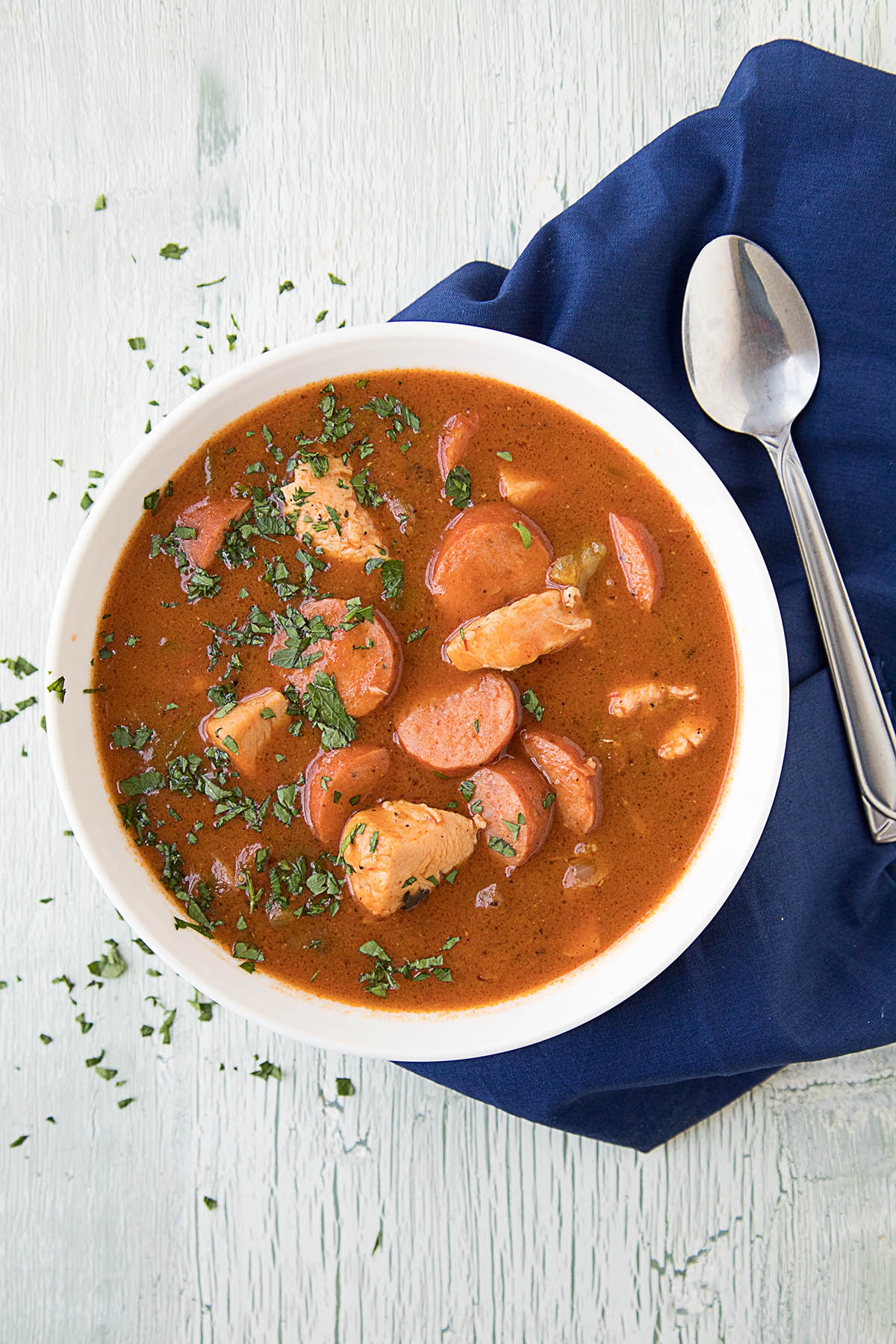
The Key to the Best Gumbo
The KEY to making a good gumbo, and I cannot emphasize this enough, is in the roux. You absolutely MUST master a proper roux if you’re going to achieve a good gumbo. Luckily it isn’t difficult.
It is essentially an equal mixture of oil and flour that is stirred slowly, continually, in a pot over low heat. You CAN use butter instead of oil, but oil is traditional, particularly peanut oil, though I’ve used different oils and everything worked out just fine.
How to Make a Gumbo Roux
Essentially, stir together the oil and flour in a large pot and bring up the heat. Keep it fairly low. Start stirring. The oil and flour will meld quickly and you’ll have a sort of liquid slurry that conforms to the bottom of the pot. If you don’t keep stirring, the roux will start to burn and you’ll have to start over, so do not stop stirring.
Stirring is a must!
You can smell it when the roux burns. It’s acrid, unpleasant, a bit like burnt popcorn. If that happens, forget it. Toss it and start over. It will ruin the flavor of the gumbo. So be careful, and don’t bring up the heat too high. Keep it low and slow.
What you’re looking for is the color of the roux. It starts out the color of flour, very light, batter-ish, but as it heats while you’re stirring, it will begin to brown, going from a light brown to the color of peanut butter or copper, and eventually to a rich chocolate brown. This can take anywhere from 20-45 minutes, depending on your desired color.
Personally, I take 20-30 minutes for my roux.
You can stop when you achieve a copper or peanut butter color. The roux is great then, coaxed of outstanding flavor. You’ll have a thicker gumbo with this color of roux.
If you continue to a darker chocolate color, you’ll have a thinner gumbo with a slightly deeper flavor, so feel free to experiment to discover which shade of roux produces the best gumbo for your taste buds.
Some cooks continue to develop their roux until it is very dark chocolate brown, almost black in color. Again, the choice is yours.
Learn more about How to Make a Roux.
Here is how my roux looks for homemade gumbo:
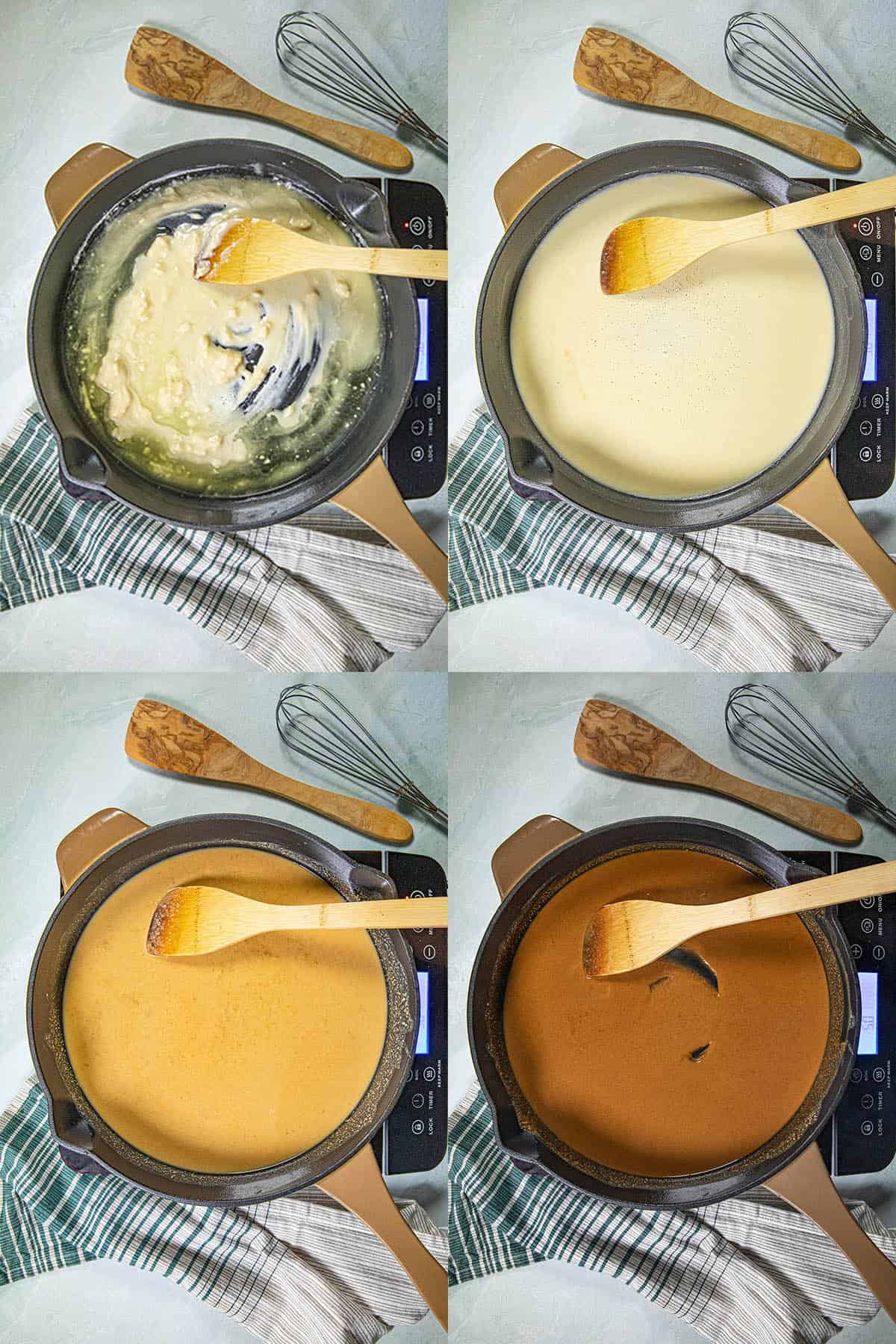
This is after about 20 minutes. If you keep cooking and stirring, the roux will turn to a brown roux the color of chocolate. A dark roux will result in a thinner final gumbo in most cases.
How to Make a Roux in the Oven
You can also make your roux for gumbo in the oven. I’ve read about some chefs in New Orleans who prefer this method, as they can make larger batches with much less effort. Even though it takes longer than traditional roux, it is much more hands off.
To make an oven roux, whisk together flour and oil in a cast iron pan or Dutch oven, then bake it at 350 degrees F for about 2-1/2 hours. Give it a good stir every 20 minutes.
Once your roux has reached your preferred color, remove it and use it as you would in any gumbo or similar recipe, such as a fricassee or etoufée.
If you make a larger batch, you can freeze your roux in containers and use later.
Making Gumbo without a Roux
While it is true that almost all gumbo starts with a roux, you can making gumbo without a roux. Emeril Lagassee of Louisiana cooking fame says that he doesn’t need to start with a roux when he’s cooking with fresh okra.
The okra acts as a thickener plenty enough. Simple chop and fry the okra in a pot until most of the slime has disappeared, then add in your vegetables and continue accordingly.
Adjusting the Heat Factor
Cajun and Creole cuisine, particularly gumbo, aren’t meant to be HOT. It is SPICY for sure, which means it includes a lot of spice and seasonings, but as a chilihead, I like to bring in a little bit of heat to please my own palate.
So, when working with the ingredients – bell peppers, onion, and celery are traditional with Cajun and Creole cooking – I like to include jalapeno peppers as well, or some other hotter peppers, depending on my mood. Here is a great example of a very hot and spicy gumbo that I love – Mike’s Spicy Gumbo, made with ghost peppers.
You can always serve your gumbo with hot sauce to spice things up.
I hope you enjoy it! People ask me for this recipe all the time, so here you go. It’s finally on the web site. Let me know how it turns out for you!
Try These Gumbo Recipes
If you love gumbo, check out some of my favorite and popular gumbo recipes.
Check out my Shrimp Creole Recipe, too. Very Cajun!
I wrote about my recent trip to New Orleans, including restaurant recommendations. Check it out here: New Orleans foodie experience. So awesome!
Check out one of my favorite easy gumbo recipes in the recipe card below. It all starts with a good roux.
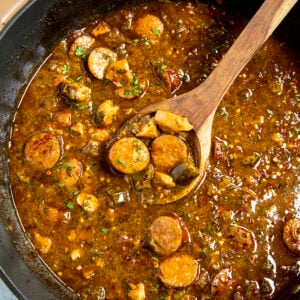
Cajun Chicken and Sausage Gumbo Recipe
This Cajun chicken and sausage gumbo recipe is made with a rich and comforting roux, loads of chicken, andouille sausage, and plenty of Cajun seasoning.
Servings: 6
Tap or hover to scale
Ingredients
- 1 teaspoon olive oil
- 1 pound chicken thighs chopped – chicken breast is good, too
- Salt and pepper to taste (I use 1 teaspoon each)
- 12 ounces andouille sliced into ¼ inch slices
- ½ cup peanut oil or vegetable oil
- ½ cup flour
- 1 medium bell pepper chopped
- 1 medium onion chopped
- 1 medium celery stalk chopped
- 3 cloves garlic chopped
- 1 cup okra I used frozen
- 2 tablespoons Cajun seasoning or more to taste
- 6 cups chicken stock
- 3 bay leaves
- 4 tablespoons chopped parsley + more for serving
- 1 tablespoon filé powder or to taste if desired
- For Serving: Cooked white rice if desired
Instructions
Heat a pan to medium heat. Add 1 teaspoon olive oil and heat.
Season chicken with salt and pepper and add to the pan along with the sliced andouille. Cook a couple minutes per side until browned. Set aside until ready to use.
Add ½ cup peanut oil to a large pot and heat to medium heat. Add flour and stir. Cook for 20-30 minutes, constantly stirring, until the roux browns to the color of chocolate.
Add peppers, onion, celery and garlic. Stir and cook about 5 minutes.
Add chicken and andouille. Stir and cook for 1 minute.
Add okra, Cajun seasoning and chicken stock. Scrape up the brown bits from the bottom.
Add bay leaves and cook at medium-low heat for 1 hour to thicken. You can simmer longer if you’d like. Taste and adjust for salt.
Stir in parsley and cook 5 minutes.
Remove from heat and stir in filé powder, if using.
Serve into a bowl, over white rice if desired, and garnish with extra parsley.
Video
Notes
If you’d like a spicier version, add in cayenne powder (or a hotter chili powder) as well as spicy chili flakes. You can also add in spicier chili peppers along with the bell peppers for some additional zest factor.
Nutrition Information
Calories: 677kcal Carbohydrates: 22g Protein: 31g Fat: 50g Saturated Fat: 12g Cholesterol: 128mg Sodium: 920mg Potassium: 794mg Fiber: 2g Sugar: 6g Vitamin A: 2225IU Vitamin C: 35.6mg Calcium: 53mg Iron: 3.2mg


BIENVENIDO
Soy Jenn Segal – Chef con entrenamiento clásico, autora de libros de cocina y mamá ocupada
Érase una vez, fui a la escuela culinaria y trabajé en restaurantes elegantes. Ahora, estoy cocinando para mi familia y comparto todas mis recetas probadas y perfeccionadas contigo aquí. Leer más…


